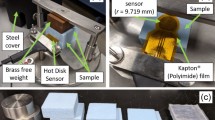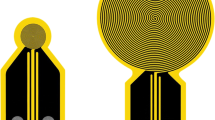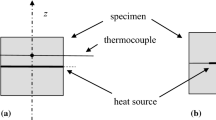Abstract
In a previous work, we developed methods based on the Pulsed Flying Spot (PFS) to estimate the thermal diffusivity on the plane of (an)isotropic materials. This thermal property is dependent on temperature or water content. In this work, we propose the device be used in transient temperature conditions to estimate the thermal diffusivity of 304L stainless steel. The first measurement in transient conditions makes it possible to simply and rapidly characterize many materials for temperature conditions other than the ambient. In the second step, we carry out transient thermal diffusivity measurements as a function of water content. We show, for a particularly heterogeneous material (a stoneware tile), that the thermal diffusivity is clearly dependent on the water content. Imbibition, for stoneware, leads to an increase in thermal diffusivity while drying leads to a decrease in the same value. This preliminary work can lead to contactless measurement of water content for different types of materials (food matrix, building materials, etc.).
Access provided by Autonomous University of Puebla. Download conference paper PDF
Similar content being viewed by others
Keywords
1 Introduction
The study of water transport during drying processes represents a serious challenge for many industries (agri-food, wood-based materials, etc.). Conventional studies monitoring moisture transport during the drying process only able to quantify water content losses over time, leading to the mass diffusion coefficient. This coefficient very often aggregates many more complex material transfer mechanisms (movement of liquid and vapor through pores under the effect of capillary forces, gravity, and pressure differences). However, conventional techniques do not allow the visualization of geometry and structure, and their effect on the transport of moisture within a porous medium, especially for anisotropic materials.
Some techniques can measure water content at local scales such as in geology where time domain reflectometry (TDR) is commonly used [1, 2]. This technique has been successfully used to monitor the progress of a wetting front in dry soils gradually moistened by irrigation.
Because of the opacity characteristics of water in its different forms (vapor or liquid), techniques for visualizing the liquid in porous media use radiation and are harmful to humans (X-ray or gamma radiation in particular). The X-ray technique has been used by [3] and [4] to visualize the effect of heterogeneous porosity on vapor diffusion inside rock slabs and to determine the absorption of two-dimensional liquid water in porous materials, such as brick and ceramics. X-ray computed tomography was used by [5] to monitor the distribution of local moisture content under transient conditions in wood samples. In studies by [6] and [7, 8], MRI was used to study water transport and wood-water interactions. In [9], MRI images acquired during baking process are presented and discussed, highlighting the need to develop quantitative methods to convert the MRI signal into a variable of interest, such as local density or local water content.
The aim of this study is to locally relate thermophysical properties, such as thermal diffusivity, to the water content of the material. Based on previous work [10] coupling the flying spot and the parabolic logarithmic method, the measurement of variation in the thermal diffusivity of a sandstone tile will be carried out during the imbibition and drying process. This work demonstrates the ability of this technique for contactless water content tracking on the surface of the material at a local scale for transient water conditions. This technique will be used and validated by measuring the thermal diffusivity of a 304L laminated stainless steel plate as a function of temperature.
2 Material and Method
The experimental set-up is shown in Fig. 1-a. A 100W CW (976 nm) laser diode is used to heat the sample surface. A scanning system based on two galvanometric mirrors (Thorlabs GVS112/M) is used to control the spatial displacement of the laser on the sample surface. An f-theta lens (focal length 250 mm) is used to focus and straighten the laser beam on the plane of the object. A dichroic mirror, treated to reflect 95% of the beam between 700 nm and 1000 nm and to transmit 95% of the infrared radiation between 2 and 16 μm is used. It allows the laser beam to be reflected perpendicular to the surface of the sample. The temperature field at the surface of the sample is recorded by an infrared camera (FLIR SC7000, 320 × 256 pixels, pitch 30 μm, spectral band 7 to 14 μm). The camera is equipped with a focal length lens equal to 25 mm which enables a spatial resolution of 250 μm per pixel as well as an analysis surface of 5 × 5 cm.
Figure 1-b highlights the 5 predominant key parameters: (i), the definition of the area to be scanned, (ii), the number of positions according to the x and/or y directions, (iii), the temporal form of the excitation at a given position, (iv), the frequency of movement between 2 positions, and (v), the number of cycles or repetitions of phases (ii) to (iv).
3 Feeding of the Method in a Transient Temperature Test
The sample is fixed on a hot plate (Fig. 1-a) and heated to a temperature of about 520 K. The hot plate is turned off and the diffusivity measurement is carried out during relaxation.
A calibration procedure is performed to quantify the heterogeneity of the sample temperature. To do this, the incident surface of the sample that will be captured by the camera is painted black, for which the emissivity of the paint is estimated at 0.92 [11]. The temperature distribution appears to be homogeneous over the entire face during relaxation (45 min). Therefore, the relaxation phase will be used for the estimation of thermal diffusivity.
During the measurement phase, only part of the sample is painted black to have access to the absolute temperature of the sample during the diffusivity estimation process. The unpainted part of the sample is dedicated to diffusivity measurement. Data processing takes about a minute.
The parabolic logarithmic method is a precursor to the estimation of thermal diffusivity in two directions (x and y shown in Fig. 1-b).
Figure 2 shows the estimated average thermal diffusivity (81 spots on an area of 25 cm2, total excitation time 2 s) as a function of temperature as well as values from the literature. It is thus noted that the results obtained are consistent with the literature, which makes it possible to validate the device and the treatment method proposed in this study.
This fast and contactless method is therefore applicable to the control and measurement of thermal properties under transient conditions. This work acts as a foundation, making it possible to evaluate the impact of severe conditions on a material (impact of oxidation on metals, variations related to degradation of composite material under high stress, etc.). The method has been validated on a transient time-temperature problem and will be used for a transient time-water content problem.
4 Contactless Transient Water Content Measurement
The experimental set-up is shown in Fig. 3. The sample is placed on a precision balance (Mettler Toledo XP203S). Every 600 s, a spot grid (GPFS) is performed and the infrared camera is synchronized to record the temperature field as a function of time for 6 s with an acquisition frequency of 200 Hz. In this study, the scanning parameters were set as follows: laser power 12 W, pulse duration 200 ms, 16 points (4 in x and 4 in y see Fig. 1.b) for a scanning area of 5 × 5 cm2.
The sample is a sandstone tile (7 × 7 cm2) and 1 cm thick. It is dried then placed on the scale, and a GPFS is performed every 60 s for 30 min. This (i) first part of the experiment gives the thermal diffusivity of the sample with a water content close to 0, the mass of the sample is concurrently recorded every 60 s. In (ii) the second step, the sample is submerged in water for 3 min in order to increase its water content. Finally (iii), the sample on the balance is replaced in the same position as in step (i). The mass is recorded every 60 s while GPFS is performed every 600 s.
Note here the large amount of data that is recorded and post-processed before and during the drying process that takes between 20 and 25 h (200 films of 200 MB). The processing time of a film is about 2.5 s.
The sandstone sample (see Fig. 1-b) (7 × 7 × 1 cm3) has a dry mass of 134.9 g, after 3 min of imbibition, it increases to 145.5 g which corresponds to a water content of 0.078 kg of water / kg of dry matter.
a-Measurement of thermal diffusivities according to x and y for the 16 spots during the whole experiment (spot number corresponding to the position is present Fig. 1-b), b-evolution of the thermal diffusivity according to y of spot No. 5 and the overall mass of the sample.
The Fig. 4-a shows the thermal diffusivity estimated according to the 16 spots in the x (left) and y (right) directions for 25 h. The data set provides 2400 points measurements according to x and 2400 according to y. Note the strong anisotropy of the material (see Fig. 4-a) with values between, on average, between 6·10–6 m2/s and 9·10–6 m2/s.
In order to show the interest of the method, we have chosen to present the variations of the thermal diffusivity of a point over time. Figure 4-b presents the thermal diffusivity in the y direction of spot n° 5 as a function of time. The following points are highlighted:
-
The thermal diffusivity is fairly stable before imbibition of the sandstone with a value on the order of 7.4·10–7 m2/s to 7.6·10–7 m2/s.
-
After imbibition, there is a clear increase in thermal diffusivity with water content until it reaches a level (9·10–6 m2/s). Simultaneously, there is a perfectly linear loss of mass (red curve). This loss of mass corresponds to an isenthalpic drying process and the evaporation of the free water of the material, which indicates that during this period, the energy brought by the ambient air to the material is used only for the evaporation of water. The temperature of the material is therefore constant and equal to the temperature of the wet bulb.
-
Beyond 18,000 s (about 5 h), the speed of water extraction slows down, indicating evaporation of water bound to the matrix (the temperature of the material approaches that of the ambient air).
-
After drying, the thermal diffusivity value tends to return to its initial value.
Figure 5 shows the thermal diffusivity in the y-direction for different spots (7 and 9). It is clear that the thermal diffusivity is highly dependent on the water content diffusivity according y increases from 7·10–7 m2/s to 10·10–7 m2/s. Spots 7 and 9 follow the same trend dependent on the water content. We can clearly conclude that the thermal diffusivity measured at the surface is correlated with the overall water content of the sample. Eventually, by carrying out a methodical calibration, this technique could allow a measurement of the water content without contacting the surface of the sample.
5 Conclusions and Perspectives
After presenting the experimental set-up, we generated a spot grid on the surface of the sample under transient time/temperature conditions for a 304L stainless steel plate and water content time for a stoneware tile. Applying the logarithmic parabolas method developed in a previous work, we estimated the thermal diffusivity in the plane with reference to the x and y axes. The first series of transient measurements as a function of temperature was carried out on a known material (304L stainless steel) to validate the proposed methodology. The results obtained are in good agreement with the literature and show the viability of this method for obtaining a large number of measurements as a function of temperature (81 spots made in 2 s repeated 35 times during relaxation). This first measurement opens up the possibility of mapping thermal properties under thermal stress and, for example, measuring the impact of oxidation of a metal under more severe conditions. This very fast measurement mode makes it possible to obtain a large amount of information on the variation or heterogeneity of diffusivity. And can be applied to many materials (composites, metals, plastics). The interest here is to be able to highlight the isotropy or anisotropy of the sample. Finally, this method was applied in a case of water content measurement on a sandstone sample during an imbibition and drying phase. Despite a very high anisotropy of the material, the measurement remains possible and shows its interest in monitoring thermal properties on a local scale. These first measurements show that it is possible to obtain a very large amount of information (2400 diffusivity measurements in the plane for each of the two directions x and y). Further post-treatment will make it possible to draw thermal diffusivity maps that are dependent on the water content of the material. Finally, on a larger time scale and after a more advanced calibration phase, the method could enable contactless water content measurement.
References
Walczak A., Szypłowska A., Janik G., Pęczkowski G.: Dynamics of volumetric moisture in sand caused by injection irrigation physical model. Water, Switzerl. 13(11), art. no. 1603 (2021)
Ledieu, J., De Ridder, P., De Clerck, P., Dautrebande, S.: A method of measuring soil moisture by time-domain reflectometry. J. Hydrol. 88(3–4), 319–328 (1986)
Tidwell, V.C., Meigs, L.C., Christian-Frear, T., Boney, C.: Effects of Spatially Heterogeneous Porosity on Matrix-Diffusion as Investigated by X Ray Absorption Imaging. Sandia National Laboratories Geohydrology Department Albuquerque, New Mexico
Roels, S., Carmeliet, J.: Analysis of moisture flow in porous materials using microfocus X-ray radiography. Int. J. Heat Mass Transf. 49, 4762–4772 (2006)
Dvinskikh, S.V., Henriksson, M., Mendicino, A.L., Fortino, S., Toratti, T.: NMR imaging study and multi-Fickian numerical simulation of moisture transfer in Norway spruce samples. Eng. Struct. 33, 3079–3086 (2011)
MacMillan, M.B., Schneider, M.H., Sharp, A.R., Balcom, B.J.: Magnetic resonance imaging of water concentration in low moisture content wood. Wood Fiber Sci. 34(2), 276–286 (2002)
Hameury, S., Sterley, M.: Magnetic resonance imaging of moisture distribution in Pinus sylvestris L. exposed to daily indoor relative humidity fluctuations. Wood Mat. Sci. Eng. 1(3), 116–126 (2007)
Ekstedt, J., Rosenkilde, A., Hameury, S., Sterley, M., Berglind, H.: Measurement of moisture content profiles in coated and uncoated Scots Pine using Magnetic Resonance Imaging, Warsaw, Poland. In: Conference—Quality Control for Wood and Wood Products (2007)
Wagner, M.J., Loubat, M., Sommier, A., Le Ray, D., Collewet, G., Broyart, B., Quintard, H., Davenel, A., Trystram, G., Lucas T.: MRI study of bread baking: experimental device and MRI signal analysis. Int. J. Food Sci. Tech. 43(6), 1129–1139 (2008)
Gaverina, L., Batsale, J.C., Sommier, A., Pradere, C.: Pulsed flying spot with the logarithmic parabolas method for the estimation of in-plane thermal diffusivity fields on heterogeneous and anisotropic materials. J. Appl. Phys. 121(11), 115105 (2017)
Jandrlić, I., Rešković, S.: Choosing the optimal coating for thermographic inspection. The Holistic App. Environ. 5(3), 127–134 (2015)
Author information
Authors and Affiliations
Corresponding author
Editor information
Editors and Affiliations
Rights and permissions
Copyright information
© 2024 The Author(s), under exclusive license to Springer Nature Switzerland AG
About this paper
Cite this paper
Sommier, A. et al. (2024). Transient Thermal Diffusivity Measurement via the Flying Spot and Parabola Method. In: Ali-Toudert, F., Draoui, A., Halouani, K., Hasnaoui, M., Jemni, A., Tadrist, L. (eds) Advances in Thermal Science and Energy. JITH 2022. Lecture Notes in Mechanical Engineering. Springer, Cham. https://doi.org/10.1007/978-3-031-43934-6_18
Download citation
DOI: https://doi.org/10.1007/978-3-031-43934-6_18
Published:
Publisher Name: Springer, Cham
Print ISBN: 978-3-031-43933-9
Online ISBN: 978-3-031-43934-6
eBook Packages: EngineeringEngineering (R0)









